Heating and Cooling
The temperature controller can be used to control heating and cooling valves. Both thermal and constant drives are supported.
Principle of operation
The following diagram illustrates the structure of the temperature controller.
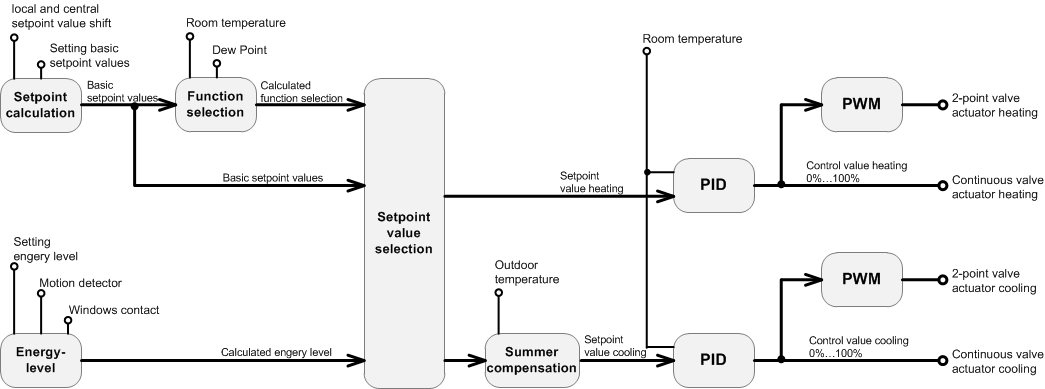
Energy level
The energy output can be adapted by the energy level to the use of the building. The longer a building or room is not used, the further the energy level can be lowered.
Energy Level | Description |
|---|---|
Comfort | If the room is occupied, it is in Comfort mode. Comfort mode can be activated by a timer switch channel or directly by presence recognition. |
Pre-comfort | The Pre-comfort energy level is for an unused room which, however, can be occupied again shortly. |
Economy | The Economy energy level is for an unused room that will only be occupied again in a few hours. Economy mode is activated, for example, at night by a timer switch channel. |
Protection | This operating mode is activated in the case of long absence times e.g. during works holidays or also when a window is open. The energy level is very low and serves only to protect the building from damage caused by frost or overheating. |
The change between the different energy levels is usually affected under time control by means of timer switch channels. Window contacts or motion sensors, which are linked by digital signals to the heating controller, can overwrite this specification. Hence, a window contact always sets the energy level to Protection. If a motion sensor is connected to the heating controller, it must be active in order that the Comfort energy level can be activated.
The calculated energy level is indicated in the Online dialog.
Setpoint value calculation
Each energy level has a base setpoint value for the heating mode and another for the cooling mode. Hence, a total of 8 base setpoint values are specified. The appropriate base setpoint value is considered depending on the energy level (Comfort, Pre-comfort, Economy or Protection) and the control function (heating or cooling).
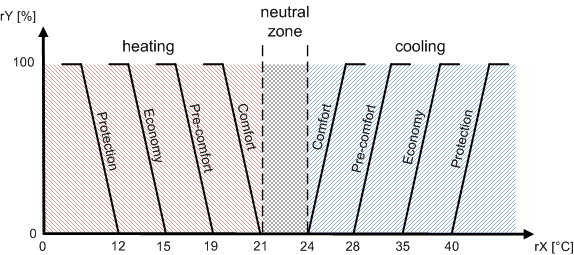
In addition to the base setpoint values, a central setpoint value shift can be specified as a parameter for both the heating and cooling modes. Furthermore, a local setpoint value shift (user setpoint value shift) can be set as a command. The local setpoint value shift can be changed, for example, by means of an analog signal (potentiometer of a room control unit).
The resulting setpoint value is composed of:
- one of the 8 base setpoint values
- the local setpoint value shift (user setpoint value shift). No effect in the case of the Protection energy level
- the central setpoint value shift. No effect in the case of the Protection energy level
- the setpoint value shift due to summer compensation.
Function selection (heating/cooling switchover)
The change between heating and cooling mode (control function) takes place automatically based on the difference between the actual and setpoint values (control deviation). The switchover can be delayed with the aid of a run-on time. If dew point sensors are linked via a digital signal group, then the cooling mode is disabled as soon as the digital signal group with the dew point sensors is active. If the actual value lies within the neutral zone, then the controller retains the current control function.
Depending on the energy level the setpoint values for heating and cooling are shifted. The size of the neutral zone also changes as a result. The following diagram shows the characteristic curves with the Pre-comfort energy level active:
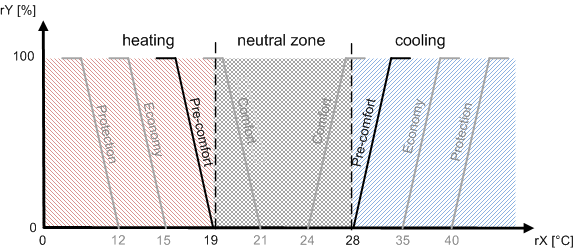
In this example the change from heating mode to cooling mode only takes place at an actual value of 28 °C or higher. If the energy level were to be set to Comfort, then the change would already take place at 24 °C. Due to this property the power requirement is reduced whilst at the same time reducing the energy level.
The calculated control function is indicated in the Online dialog.
Summer compensation
With the aid of this summer compensation, overly large temperature differences between the outside temperature and the room temperature are avoided in summer. This helps to save energy whilst at the same time increasing comfort. If the outside temperature exceeds an adjustable limit value, then the setpoint value is raised. The factor by which the setpoint value is raised can be set from 0.0 to 10.0.
Settings
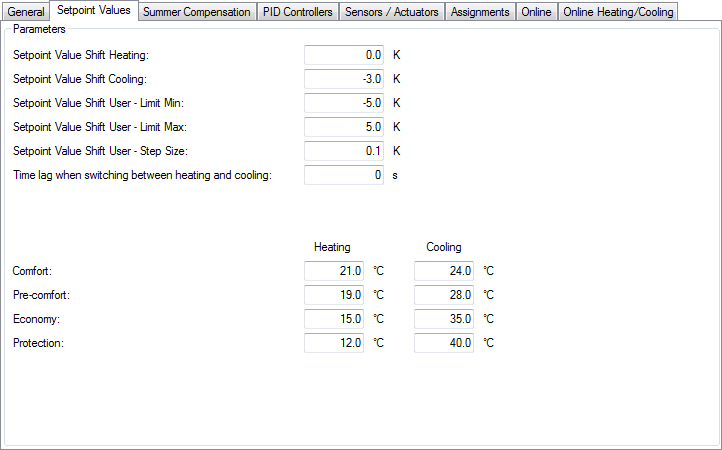
Parameters
- Setpoint Value Shift Heating: central setpoint value shift during heating.
If the setpoint value shift for heating lies in the positive range, then this affects the following setpoint values: - HeatingCoolingEnergy Level Protection Economy Pre-comfort Comfort Comfort Pre-comfort Economy ProtectionBase Setpoint Value [°C]1215192124283540Setpoint Value Shift [K]---+3+3+3--Setpoint Value [°C]1215192427313540 If the setpoint value shift for heating lies in the negative range, then this affects the following setpoint values:
- HeatingCoolingEnergy Level Protection Economy Pre-comfort Comfort Comfort Pre-comfort Economy ProtectionBase Setpoint Value [°C]1215192124283540Setpoint Value Shift [K]---3-3----Setpoint Value [°C]1215161824283540
- Setpoint Value Shift Cooling: central setpoint value shift during cooling.
If the setpoint value shift for cooling lies in the positive range, then this affects the following setpoint values: - HeatingCoolingEnergy Level Protection Economy Pre-comfort Comfort Comfort Pre-comfort Economy ProtectionBase Setpoint Value [°C]1215192124283540Setpoint Value Shift [K]----+3+3--Setpoint Value [°C]1215192127313540 If the setpoint value shift for cooling lies in the negative range, then this affects the following setpoint values:
- HeatingCoolingEnergy Level Protection Economy Pre-comfort Comfort Comfort Pre-comfort Economy ProtectionBase Setpoint Value [°C]1215192124283540Setpoint Value Shift [K]-----3---Setpoint Value [°C]1215192121283540 If the setpoint value for Pre-comfort is shifted beyond Economy, then the setpoint value for Economy is shifted with it.
- HeatingCoolingEnergy Level Protection Economy Pre-comfort Comfort Comfort Pre-comfort Economy ProtectionBase Setpoint Value [°C]1215192124283540Setpoint Value Shift [K]----+8+8--Setpoint Value [°C]1215192124283540
- Setpoint Value Shift User - Limit Min: lower limit for the local setpoint value shift.
- Setpoint Value Shift User - Limit Max: upper limit for the local setpoint value shift.
- Setpoint Value Shift User - Step Size: step size for the local setpoint value shift.
- Time lag when switching between heating and cooling: time delay before switching between heating and cooling (control function).
- Comfort: If the Comfort energy level is active, then the corresponding setpoint value is used as the base setpoint value.
- Pre-comfort: If the Pre-comfort energy level is active, then the corresponding setpoint value is used as the base setpoint value.
- Economy: If the Economy energy level is active, then the corresponding setpoint value is used as the base setpoint value.
- Protection: If the Protection energy level is active, then the corresponding setpoint value is used as the base setpoint value.
Summer compensation

Parameters
- Enable: enable/disable the summer compensation.
- Start Level - Outdoor Temperature: outdoor temperature at which the adaptation of the setpoint value by the specified factor begins.
- End Level - Outdoor Temperature: outdoor temperature at which the adaptation of the setpoint value by the specified factor ends.
- Gradient: Factor by which the setpoint value is adapted. The value may not be less than 0 or greater than 10.
PID controller
Separate PID controllers are available for the heating and cooling control functions. The controller parameters can be set in this dialog.
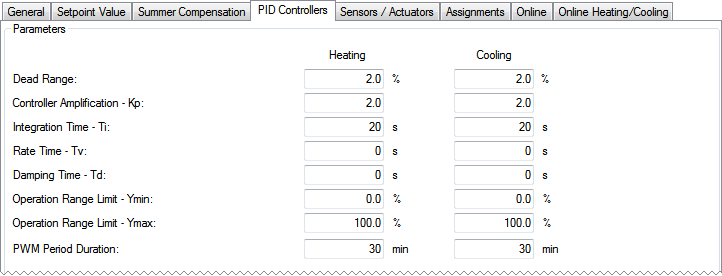
Parameter
- Dead Range: To prevent unnecessary movement and thus premature wear of the valves, a dead range can be set for the output signal.
- Controller Amplification - Kp: amplification of the controller.
- Integration Time - Ti: integration time of the controller.
- Rate Time - Tv: rate time of the controller.
- Damping Time - Td: damping time of the controller.
- Operation Range Limit - Ymin: lower limit of the operating range.
- Operation Range Limit - Ymax: upper limit of the operating range.
- PWM Period Duration: period of the PWM signal. The PWM signal controls the thermal drives.
Sensors / Actuators
The sensors and actuators that are necessary for control are entered in this dialog.
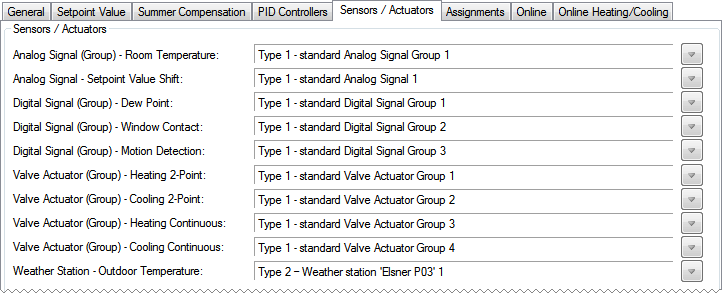
Online
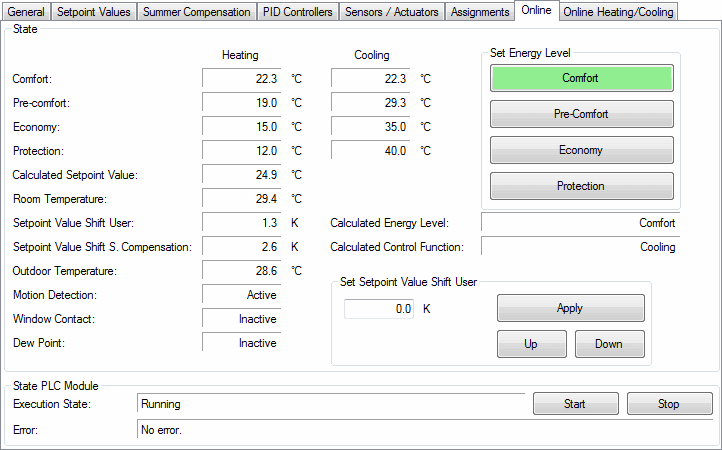
Commands
- Set Energy Level: The desired energy level can be selected using these four buttons. The value can be overwritten by window contacts or motion sensors.
- Set Setpoint Value Shift User: the local setpoint value shift (setpoint value shift user) can be changed in this field. The Up and Down buttons respectively increase or decrease the local setpoint value shift. The Setpoint Value Shift User – Step Size parameter (see Settings dialog) specifies the step size by which the local setpoint value shift should change. This field is not displayed if an analog signal has been selected for the setpoint value shift in the Sensors/Actuators dialog.
If the setpoint value shift lies in the positive range, then this affects the following setpoint values: - HeatingCoolingEnergy Level Protection Economy Pre-comfort Comfort Comfort Pre-comfort Economy ProtectionBase Setpoint Value [°C]1215192124283540Setpoint Value Shift [K]---+3+3+3--Setpoint Value [°C]1215192427313540
If the setpoint value shift lies in the negative range, then this affects the following setpoint values: - HeatingCoolingEnergy Level Protection Economy Pre-comfort Comfort Comfort Pre-comfort Economy ProtectionBase Setpoint Value [°C]1215192124283540Setpoint Value Shift [K]---3-3-3---Setpoint Value [°C]1215161821313540
State
- Comfort, Pre-comfort, Economy and Protection: calculated setpoint values for the individual energy levels and control functions.
- Calculated Setpoint Value: Setpoint value to be referred to for further control. The calculated energy level and the calculated control function determine which of the 8 setpoint values is used.
- Room Temperature: current room temperature (actual value).
- Setpoint Value Shift User: indicates the local setpoint value shift (user setpoint value shift).
- Setpoint Value Shift S. Compensation: indicates the setpoint value shift of the summer compensation.
- Outdoor Temperature: indicates the outdoor temperature if a weather station has been connected to the air conditioning controller.
- Motion Detection: indicates the state of the motion sensors, if motion sensors have been connected to the air conditioning controller.
- Window Contact: indicates the state of the window contacts, if window contacts have been connected to the air conditioning controller.
- Dew Point: indicates the state of the dew point sensor, if dew point sensors have been connected to the air conditioning controller.
- Calculated Energy Level: the actual energy level. This results from the specified energy level and optionally from the states of the motion sensors and window contacts.
- Calculated Control Function: the actual control function. This results from the control deviation and optionally from the states of the dew point sensors.
State PLC Module
- Execution State: shows, if the module is running or stopped.
- Error: in case of an error, the error code and the error parameter is displayed in this box.
- Start/Stop: starts/stops the module.
Online Heating/Cooling

State
- Continuous Control Value: control value for controlling the constant valve actuators.
- Clocked Control Value: control value for controlling the thermal valve actuators.
- Deviation: difference between setpoint value and actual value (setpoint value - actual value).